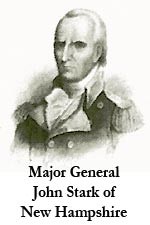The Battle of Bennington
Turning point of the American Revolution
The British Plan/Objectives and Failures Prior To Battle of Bennington:
The British plan, under the command of General John Borgoyne, had been to cut New England off from the other colonies. With the British recapture of Fort Ticonderoga and the resulting American evacuation of Mount Independence in Orwell, Vermont, the British advance southward had been temporarily stopped at Hubbardton, the only Revolutionary War battle fought entirely on Vermont soil. This tactical victory gave the Colonial forces a chance to regroup and forged the first successful resistance to Burgoyne‘s plan.
As a result of these engagements, the British were in need of military stores and supplies. With reports that substantial stores were in the Bennington area, two of Burgoyne’s units (under the command of Lieutenant Colonels Friedrich Baum and Heinrich von Breymann) of approximately 700 British, Indian, Loyalist and German mercenaries headed for the arsenal depot located at the present Monument site.
Introduction:
Vermont’s unique holiday on August 16th is in honor of the Revolutionary War Battle of Bennington. Here Brigadier General John Stark and his American forces successfully defeated two detachments of invading army in 1777. Following the Battle, Burgoyne wrote to his superior, Lord Germaine, “The New Hampshire Grants in particular, a country unpeopled and almost unknown in the last war, now abounds in the most active and most rebellious race on the continent and hangs like a gathering storm on my left.”
The Events and Expectations of August 1777:
Alarmed at the pace and probable success of Burgoyne’s advancing army, the newly formed Republic of Vermont, through its Council of Safety and without the knowledge of the British forces, appealed to neighboring New Hampshire for assistance against the increasing British attacks and invasions. Burgoyne has gone down in history as one of Britain’s more successful generals and carried the nickname “Gentleman Johnny,” given to him by his troops because of the humane and understanding manner with which he treated them.
The Colonial forces chose as their leader retired Continental Army Colonel John Stark, who had fought at Bunker Hill and under George Washington at Trenton and Princeton. Given the rank of Brigadier General, Stark accepted the challenge under the independent authority granted by New Hampshire rather than under Continental Command. Under Stark’s command was the entire Bennington force, consisting of approximately 2,000 Vermont, New Hampshire and Berkshire County (Massachusetts) volunteers, most of whom were untrained.
Aware of the advancing British troops moving east toward Bennington, Stark decided to head them off rather than defend the supply depot at the Bennington site. Therefore, it was approximately five miles northwest of Bennington, near Walloomsac Heights in New York State, that the actual battle took place.
The Battle of Bennington: (August 16, 1777)
Hampered by heavy rains, the British had halted their advance and were encamped on the south slope parallel to the Walloomsac River. General Stark, assessing the British position, sent detachments under Colonel Moses Nichols to circle Baum’s left, under Colonel Samuel Herrick to circle the right, and under Colonels David Hobart and Thomas Stickney to the south. Stark, along with the remaining men, made the principal frontal attack on the British lines.
Initial Colonial Success Followed by Renewed British Pressure:
The fighting began at three o’clock on the afternoon of August 16th. Folklore has Stark uttering the immortal words, “There are the Red Coats; they will be ours or tonight Molly Stark sleeps a widow.” The first shot was fired by Nichols’ battalion; and by five o’clock that evening, the British troops were retreating in disorder. Baum received a mortal wound at this stage of the battle and his demoralized troops surrendered. General Stark later described this engagement as “one continuous clap of thunder.”
As General Stark was taking the captured and wounded enemy soldiers back to Bennington, Colonel Breymann appeared with a second unit of Burgoyne’s army, surprising Stark and his men. The Americans fought back; but exhausted and hungry, they slowly gave ground.
The Turning Point and the Road to Colonial Victory
Then suddenly, arriving overland from Manchester, Colonel Seth Warner and his Green Mountain Boys came to their aid. With this additional help and reinforcement, the scales were tipped in the Americans’ favor and Breymann’s ranks gave way. By dusk they were fleeing, with the Americans in hot pursuit.
Important Results and Outcomes:
The Battle of Bennington was of no small consequence. The mostly untrained Yankees had overwhelmingly defeated some of Europe’s best trained, disciplined and equipped troops. A large percentage of Burgoyne’s army had been killed, wounded or captured and much of their already short supply of needed military stores had been captured by the American forces. The Americans’ valuable stock of stores and supplies had been saved, and Burgoyne’s ambitious plan for a quick march to Albany had been halted.
Due in large part to the lack of the much needed supplies, Burgoyne, on October 17, 1777, surrendered with his entire command of some 8,000 British, Hessian and Brunswick troops at Stillwater, New York, following the Battle of Saratoga, a major turning point for the American Revolution. New England would not be cut off from the rest of the colonies.
